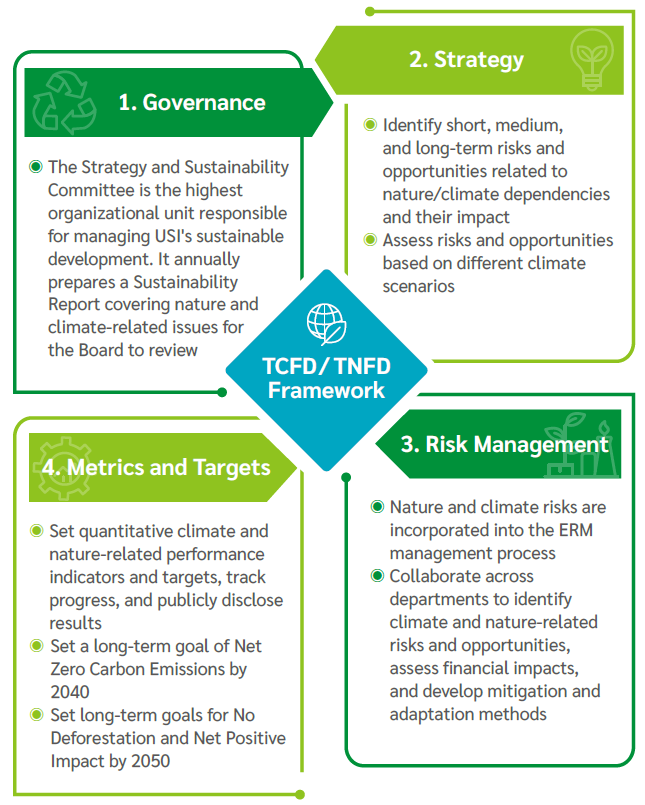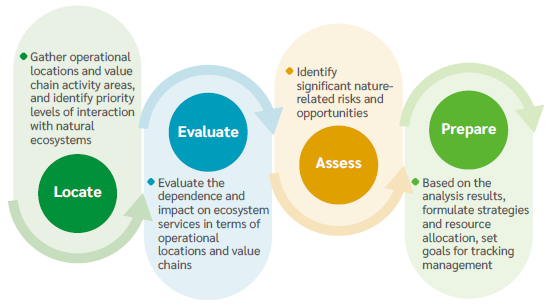
Environmental Protection and Occupational Safety
Nature, Climate Change
The global warming caused by GHG emissions over the years has exposed the world economy to significant risks and has threatened many businesses around the world. Accordingly, stakeholders have started to pay attention to climate-related risks and opportunities. The Company also supports and responds to the goal of the Paris Agreement and has explicitly disclosed the risks and opportunities faced by the Company due to climate change and related to the nature according to the TCFD & TNFD frameworks, thereby proposing corresponding strategies and measures.
The USI Sustainability Committee is the dedicated unit for climate change related management to understand and analyze sustainable development topics related to the Company according to various domestic and foreign sustainable development and climate change related international initiative activities.

For analysis of the financial impact of climate change risks and opportunities, refer to the International Energy Agency (IEA), the International Renewable Energy Agency (IRENA), the Intergovernmental Panel on Climate Change Sixth Assessment Reports (IPCC AR6), and the Nationally Determined Contribution (NDC) situational parameters set for each manufacturing location. The risks and opportunities of the company's entities and transformation are analyzed with relevant units within the organization.
Based on the risk and opportunity matrix identification results, climate risk projects of high concern are managed from two aspects: "Mitigation and Adaptation". In terms of mitigation, we actively promote sustainable manufacturing, use of renewable energy and improve energy resource efficiency; in terms of adaptation, we strengthen the company's climate resilience and search for alternative energy sources, analyze the risks of climate change and propose research and development strategies, provide customers with integrated solutions, and help customers adapt to climate change.
TCFD Material Financial Impact Analysis
| Risks and Opportunities Description | Estimated Financial Impact | Estimated Costs | Impact Time | |
| Transition Risk | Mainland China has committed to achieving Carbon Neutrality by 2060 and peaking GHG by 2030. The market transaction electricity price fluctuates within a range of 20%. | The average electricity price at our facilities in China is CNY 0.78 per kWh. The estimated 20% increase would raise the price by CNY 0.16 per kWh. Based on the 2024 purchased electricity of 212,716 thousand kWh, the estimated additional expenditure would amount to CNY 34 million. | To enhance energy efficiency and reduce consumption, we estimate the investment of CNY 12 million in power engineering and system upgrades. | 5 years |
| Taiwan aims for a Nuclear-free Homeland and is promoting energy transition, reducing reliance on fossil fuels, and increasing the proportion of renewable energy and natural gas power generation, which poses a 45% risk of electricity price increases. | The average electricity price at our Nantou facility is CNY 0.78 per kWh. The estimated 45% increase would raise the price by CNY 0.36 per kWh. Based on the 2024 purchased electricity of 46,627 thousand kWh, the estimated additional expenditure would be CNY 17 million. | |||
| Physical Risk | Climate change has heightened the frequency of natural disasters, such as droughts leading to delays in supplier deliveries or material shortages, potentially resulting in a 30% production loss if a production line is halted for one day. | Based on the 2024 total revenue of approximately CNY 60.7 billion, the estimated impact cost is approximately CNY 500 million. | Our facilities in Mainland China anticipate a 4.03% reduction in rainfall. In 2024, with a total water usage of 673 million liters, an additional 27 million liters would be required, costing approximately CNY 0.2 million for water truck services. | 1 years |
| The Nantou facility anticipates a 0.72% reduction in rainfall. In 2024, with a total water usage of 198 million liters, an additional 1.4 million liters would be needed, costing approximately CNY 3 million for water truck services. | ||||
| The Mexico facility anticipates a 4.03% reduction in rainfall. In 2024, with a total water usage of 62 million liters, an additional 2.5 million liters would be required, costing approximately CNY 2 million for water truck services. | ||||
| Opportunity | Electric vehicles (EVs), featuring high efficiency, low energy consumption, and minimal GHG emissions, are gaining market traction and popularity worldwide. Governments globally are offering subsidies and promoting EV adoption, driving demand for Ev-related components and energy technologies. The penetration rate of EVs and non-fuel powered vehicles is expected to reach 75% by 2035, potentially increasing revenue for companies manufacturing EV-related components. | In 2024, our automotive electronics product revenue was approximately CNY 1,996 million, with EV-related products comprising 25%. The compound annual growth rate (CAGR) in the automotive sector is projected to rise by 20%, potentially boosting revenue by CNY 60 million (CNY 1,996 million x 25% (share of automotive products) x 20%(CAGR)). |
1. R&D costs: Collaboration with R&D talent and suppliers is essential to develop products aligned with customer needs. 2. Certification costs: Post product development, various certifications for materials, finished products, and partner factories must be obtained. 3. Management and overhead costs: Additional management personnel are required for regular updates on regulations and material applications, necessitating an estimated annual investment of CNY 1 million for development costs. |
5 years |
In 2025, USI aligned with ASE Technology Holding to reaffirm its SBTi-approved 1.5°C climate target and set net-zero goals by 2050. The company also committed to a 90% absolute reduction in Scope 1, 2, and 3 emissions by 2040, supported by 10% carbon credits, delivering sustainable, low-carbon solutions to customers.
At the same time, a systematic disclosure structure will be used to demonstrate the efforts and results in response to climate change, further enhance awareness of the climate crisis, formulate relevant mitigation plans and measures, accelerate the implementation of risk control and climate change mitigation actions, and strengthen ongoing management of operations. capabilities and move towards sustainable development of the enterprise.
Net Zero Carbon Emissions Roadmap

USI attaches great importance to the supply, regulation, support and cultural services provided by the ecosystem for company operations, and is committed to reducing the impact on the ecosystem. Currently, the Mainland China, Nantou, Mexico and Vietnam facilities are all located in high-tech parks and industrial parks. None of the parks are located in biodiversity-sensitive areas.
Biodiversity Commitment
To achieve a balanced coexistence and maintain the integrity of natural ecosystems and forest conservation, USI established our Biodiversity and No Deforestation Commitment and publicly disclosed our biodiversity targets:
- Target Objective:to work towards No Net Loss (NNL) and No Gross Deforestation across our operations and value chain, we establish a global monitoring system to track biodiversity loss and comply with statutory biodiversity and forest conservation regulations, reducing environmental impacts and dependencies in the best practicable way.
- Risk Assessment:USI engages with internal and external stakeholders to assess potential biodiversity and deforestation risks following international guidelines. We analyze dependencies and impacts, consider local operational and ecological characteristics, identify priority areas to work on, and manage material risks by developing action plans with clear and measurable metrics.
- Mitigating Impact:to balance our impact on the ecosystem, USI adopts a nature-based mitigation hierarchy approach of prevention, mitigation, restoration, and offsetting throughout the operation life cycle to investigate and monitor material risks, protect biodiversity and ecosystem services, and prevent deforestation or invasive species.
- Scope of Coverage:all operations, suppliers, and partners are subject to the Commitment. New Facilities and value chain operational activities are prohibited, where avoidable, to be located near sites containing globally or nationally important biodiversity, environmentally-sensitive hotspots, ecological corridors, in areas contiguous with hydrological and vegetation conditions, or the vicinity of the sites mentioned above.
With the Board of Directors' endorsement and approval, this Commitment is implemented across all operating sites, subsidiaries, suppliers, and business partners inside and outside the value chain worldwide to achieve the long-term goal of 2050 Net Positive Impact (NPI).
As part of our restoration efforts, USI began afforestation in partnership with an organization in 2013 to increase biodiversity and soil and water conservation. In addition, to reduce the Potentially Disappeared Fraction of species and achieve No Gross Deforestation by 2050, USI continues the hierarchical mitigation approach of prevention, mitigation, restoration, and offsetting in our facilities and carry out measures such as energy saving, carbon reduction, and resource recovery to ameliorate our impact.
Biodiversity Dependence and Impact Analysis
We use the LEAP (Locate, Evaluate, Assess, Prepare) process recommended by the TNFD framework to conduct biodiversity dependence and impact assessments on USI's existing own sites and supplier sites.
Biodiversity Risk Assessment Process

A questionnaire survey was conducted at each facility site of the company, and the identification results of natural dependence categories in each facility area showed that the issue that affects the most facility areas is high temperature, followed by extreme rainfall and stronger wind disasters. The two disasters of "uneven rainfall" and "drought occurrence" have a high impact before adjustment. All disaster risks have a downward trend after the implementation of adaptation actions in each factory area. The identification results of the natural impact categories of each factory area show that the highest impact (pollution) issues caused by the factory area on nature include waste, greenhouse gas emissions, and air pollution emissions, followed by indirect energy use, direct use of fossil fuels, and use of fresh water resources.


